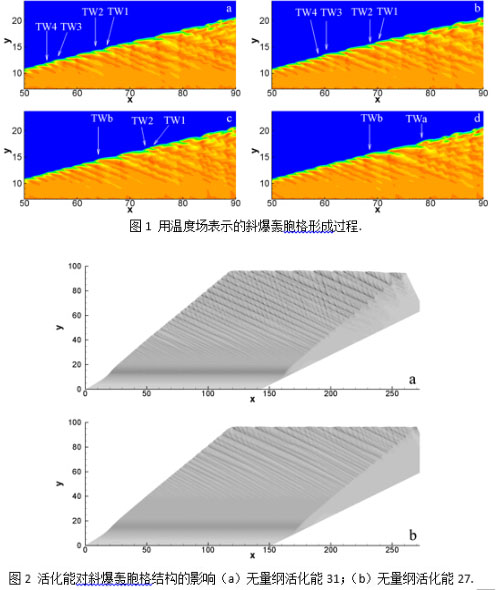
Detonation wave is a kind of special combustion wave, the main feature is the use of shock compression to achieve self-ignition, and rapid heat release under high pressure. As the most rapid combustion method, the organization of detonation and combustion in the engine has become a difficult but very attractive idea, and has received extensive attention from the international academic community. In recent decades, researchers have proposed a variety of engine solutions based on detonation combustion, in which the oblique detonation stamping propulsion not only has the advantages of rapid combustion and high thermal cycle efficiency, but also combines the advantages of conventional scramjet presses in The hypersonic advance with a Mach number greater than 10 has great potential for application.
Due to the inherent instability of the detonation wave, the coupling structure of the shock wave and the combustion will destabilize to form a complex cell structure. In oblique detonation propulsion, this cell structure will have an impact on the combustion efficiency and propulsion performance of the engine, and it has become one of the key scientific issues in oblique detonation research. However, it is very difficult to form a standing oblique detonation wave in high-speed flow, and the wave surface destabilization process is very sensitive to the incoming flow disturbance, so it is very difficult to study. The shock and detonation physics team of the State Key Laboratory of High-temperature Gas Dynamics, Institute of Mechanics, Chinese Academy of Sciences, has studied the structure and stability of oblique detonation, and has made progress in the cell formation mechanism and its quantification law. The design of the oblique detonation stamping propulsion system has been promoted.
Previous studies have shown that the detonation wavefront destabilizes under small perturbations, indicating that the wavefront itself is intrinsically unstable, but the cell formation mechanism after destabilization is unclear. Figure 1 shows the dynamics of oblique detonation cell formation after wavefront instability. The weak transverse wave (TW1-TW4) formed by the destabilization achieves self-reinforcement through collision and consolidation in the process of downstream propagation, and further develops into a stronger left transverse wave (TWa-TWb). This left-hand transverse wave spacing is relatively large, which induces the formation of another set of right-hand transverse waves, which together constitute the final morphology of the oblique detonation cell. This is similar to the process in which the detonation of an overdrive detonation is a CJ detonation wave in the beginning of a general detonation wave. It can therefore be concluded that the oblique detonation waves in the high-velocity gas stream are consistent with the cell formation mechanism of the multi-dimensional detonation waves in the stationary gas.
In order to quantitatively study the destabilization characteristics of oblique detonation waves, Figure 2 shows the effect of different activation energy on the oblique detonation cell structure using a numerical smoke foil record. It can be seen that the high activation energy oblique detonation Waves are easily destabilized and low activation energy is not easily destabilized. In this study, the quantitative statistics of the formation of cellular structures after destabilization were analyzed for the first time by introducing dynamic statistical methods for the analysis of complex flow fields. The results show that under low activation energy conditions, the formation law of cell structure and the law of instability are qualitatively consistent, but under the condition of high activation energy, the formation rule and instability law of cell structure have deviated. The results not only reveal the complexity of cell formation, but also provide a basis for the prediction of wavefront structure.
The above findings are published in the Combustion and Flame (Evolution of cellular structure on oblique detonation surfaces. Teng, Honghui; Ng, Hoi Dick; Li, Kang; Luo, Changtong; Jiang, Zonglin. Combustion and Flame, 2015, 162 : 470-477.) The study was supported by the National Natural Science Foundation of China and the Youth Innovation Promotion Association of the Chinese Academy of Sciences.
Ceiling Shower Arm,Ceiling Arm,Shower Head Ceiling Arm,Ceiling Fed Shower Arm
Moon Shower Sanitaryware Co.,Ltd , https://www.moonshowerglobal.com